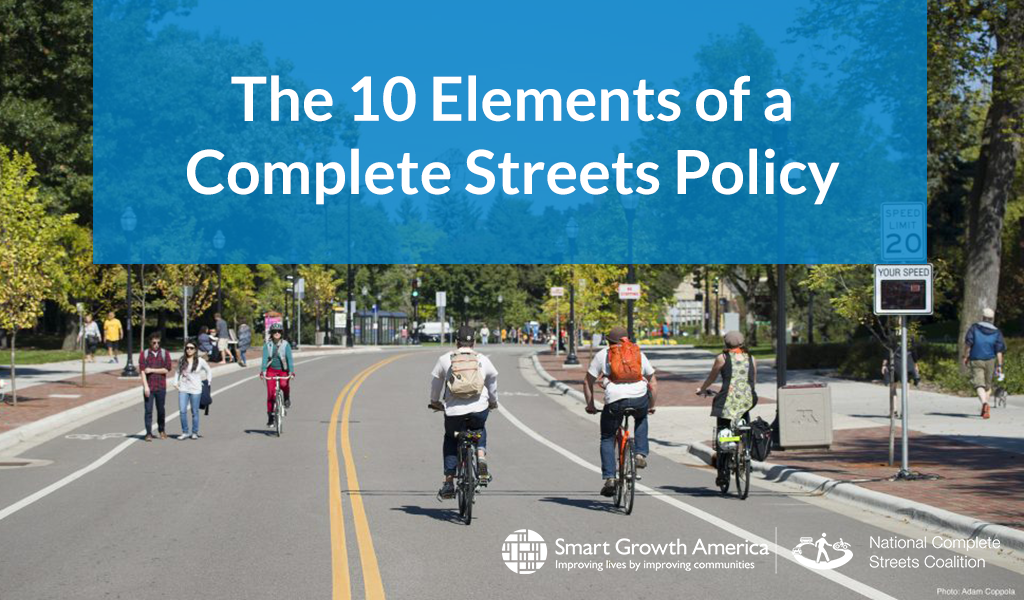Adopting a strong Complete Streets policy
Complete Streets is an approach to planning, designing and building streets that enables safe access for all users, including pedestrians, bicyclists, motorists and transit riders of all ages and abilities. This approach also emphasizes the needs of those who have experienced systemic underinvestment, or those whose needs have not been met through a traditional transportation approach.
A Complete Streets policy specifies how a community will plan, design, and maintain streets so they are safe for all users of all ages and abilities. A strong policy begins transforming a community’s practices, processes, and plans.
What constitutes a great Complete Streets Policy?
The best policies have evolved to focus far more on implementation and equity. I.e, are policies actually being fully implemented in order to change what gets built and where? And do they prioritize improving equity in tangible ways? As noted below, the strongest policies incorporate all ten of the elements laid out in our policy framework.
Read about the ten elements in the ideal Complete Streets policyAdopt a Complete Streets policy
Adopting a policy may seem overwhelming, so consider these simple steps when starting your process:
Identify a broad set of partners
Take some time to identify the right partners. Who cares about this work (local transportation advocates, neighborhood-based groups, public health agencies)? Who makes decisions about this (transportation government agencies, elected leaders)? Who shares similar goals but may not seem like obvious partners (disability advocates, healthcare partners, real estate associations, community development groups, public safety agencies). Also, consider how your partners relate to the communities you’re trying to serve. Are they members of the community? Do they have shared or similar experiences? Consistently putting the community you are trying to serve at the center of your work is key to developing an equitable policy.
Build a coalition
Bring together your partners and discuss the goals for your policy. Why is your community interested in adopting a Complete Streets policy? Take time to outline your goals; this will set your foundation, ensure everyone is on the same page, and make it easier to start drafting a policy, which always should start with a clear vision and purpose.
Draft your policy using the 10 elements
When your coalition is ready to begin drafting the policy, our 10 Elements of a Complete Streets Policy is the best starting place. Based on nearly two decades of real-world experience and best practices, it provides a framework for designing the strongest possible policy, specific ideas on what you might want to prioritize, and suggestions on how to make your policy binding.
Evaluate your policy
We regularly evaluate and score policies using our policy framework. Now, advocates and policymakers can do the same, using our free and open-source tool to evaluate existing or drafted local, MPO, or state-level Complete Streets policies. Learn more and evaluate your policy.
Determine the best policy format
Complete Streets policies can take a variety of formats: from ordinances adopted by city and county councils to executive orders from elected officials, such as mayors or governors. Whatever format you take, make sure that your policy is binding and requires government agencies to change their approach.
Identify the steps for passing a policy in your community
The format of your policy will determine the steps needed to formally adopt your policy. Your government partner(s) and elected officials will be able to help shepherd this process.
Adopt your policy and celebrate the win!
While adopting a policy is just the first step in Complete Streets implementation, it’s important to gather your coalition and community to celebrate the work it took to come this far. This is especially important if your coalition is planning to continue with a new goal or project. Read more about how Baltimore, MD passed its Complete Streets policy.
Putting a Complete Streets policy into practice
A strong policy is the first step in a much longer process to shape practices for street design. Changing those practices is a key step in making a Complete Streets approach the default approach. Those practices determine the projects that get built and how, which are the building blocks of creating a complete network to serve everyone and connect more people to destinations safely and efficiently.

A policy that never gets implemented to shape practices and projects is just a piece of paper, so this is where the work truly begins. The National Complete Streets Coalition suggests the following key steps to put a policy into practice:
1) Change procedures and processes
Agencies must review and update all of their existing procedures, plans, regulations and processes to accommodate all users on every project. This might include incorporating Complete Streets checklists or other tools into the decision-making process.
2) Review and revise design guidance
At many transportation agencies, the (street) design manual is the go-to reference for all projects. Agencies need to develop new design policies and guides or revise existing ones to reflect the current state of best practices in transportation design. Communities may also elect to adopt national or state-level recognized design guidance. (The strongest policies include binding language on adopting the best in class design guidance.)
3) Never stop training agency staff and community members
Offer workshops and other training opportunities to transportation staff, community leaders, and the general public so that everyone understands the importance of the Complete Streets vision—and how to execute it. Some communities record training modules for new staff on-boarding processes while ensuring that the content is updated as systems and processes evolve.
4) Establish and regularly report on new performance measures
The strongest policies measure their own progress by creating new performance measures that the public can easily access, and then regularly reporting on them. These measures (like number of roadway fatalities and injuries, quality and quantity of community engagement, new staff hired/trained, improved access to resources, etc) need to be agreed upon as a policy is institutionalized so success can be tracked and the impact on a community can be measured.
5) Begin transforming the project selection process
Every community—local, county, metro area, state—has a process in place for selecting transportation projects for funding. A strong policy changes the criteria for choosing them so that Complete Streets projects are prioritized and that it is done equitably. Consider the examples of Howard County’s (MD) capital transportation project prioritization scoring system and Milwaukee’s Complete Streets handbook that uses various criteria including their Neighborhood Revitalization Strategy Areas.
6) Create a committee to oversee implementation
This is a critical accountability measure to ensure the policy becomes the norm. The committee should include public agency staff and residents, as well as representatives from advocacy groups, underinvested communities, and vulnerable populations such as people of color, older adults, children, low-income communities, non-native English speakers, those who do not own or cannot access a car, and those living with disabilities. Roles and responsibilities of this group will look different in different communities. Consider examples from the Complete Streets Committee in Milwaukee, WI and inter-agency advisory committee in Baltimore, MD.
7) Create an inclusive community engagement plan
Create a community engagement plan that prioritizes equity by focusing outreach efforts on underrepresented and underinvested communities. The best community engagement doesn’t require people to alter their daily routines to participate.
8) Build Complete Streets projects
It needs saying: The entire point of passing a policy and putting it into practice is to build a network of safer, more Complete Streets. Never lose sight of this. If you never reach this step, then you should completely reconsider your policy’s language or the steps you’ve taken to put it into practice. This is also not a final step, as many of the steps preceding it are ongoing, overlapping, and concurrent. Try to build Complete Streets from day one, even as you go through the steps of fully putting your policy into practice, and then try to build even better Complete Streets as you learn and iterate.
Learn more about adopting a strong policy in our 10 Elements of a Complete Streets Policy ››

